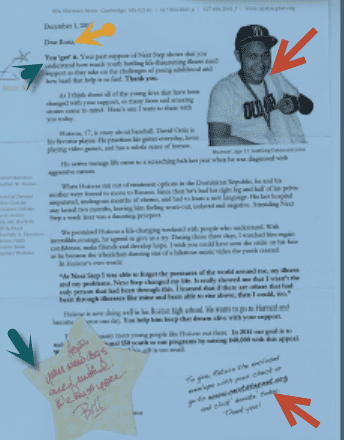What should you do to interest a potential donor–and what shouldn’t you do? Let me tell you a story that will help you answer the question yourself.
Recently, my wife, Rona, thought about signing up for a service online. She went to the sign-up page, but she was dismayed at how much personal information the company was asking for upfront: not only name and email, but address, home phone, cell phone, location…Midway through the process, she clicked off.
The next thing you know, the company had mailed her at her home address. She knew it was them even before she opened the envelope. She’d used her “maiden name” to sign up, and that was on the mailing!
How do you think Rona felt? (How would you feel?)
Don’t be a Home Invader
Whether it’s a commercial organization or a nonprofit, there are things you just can’t do to interest a customer, or donor, in your business.
Let’s start with: you can’t ask for too much information at one time. It takes too long, and it raises suspicion that you might be using the data for nefarious purposes.
Your landing page needs to be as simple as you can make it. Name and email address might be all you need.
Then: you have to be prepared to take no for an answer. Just because you want that person’s attention–or donation–doesn’t mean they have to give it to you. Pursuing them is creepy…especially if you do it across platforms.
Imagine you knocked at my door, and I didn’t respond. You knew I was there, because the light was on and you heard me moving around. Would it be okay to climb in through the window and say hello? Of course not! Then why would it be okay to send me mail when I hadn’t even authorized you to send me email?
Be a Welcome Guest Instead. Here’s How.
Of course, you do want people who are interested in your nonprofit to hear from you. But there’s a wrong way to do that…and then, there’s a right way. If you do the right thing, you can be a welcome guest in their inbox.
The key is to offer your audiences content that’s so good and so useful to them, they keep coming back for more–and telling their friends. How do you do that? Here are five steps to take.
- Commit to doing better. Most nonprofits are happy just to be producing content at all. As Kivi Leroux Miller tells us, it’s time to question that approach.
- Know your audience. Know them so well you’d recognize them on the street. (John Haydon’s Nonprofit Marketing Personas Workbook will help you there.)
- Have a strategy. It can be as simple as “Who are the audiences we’re trying to reach? What do we already know about these audiences? What do we need to find out to give them what they’re looking for? What will they do differently if we succeed?”
- Keep it exciting. Look for ways to give your audiences useful information in a variety of forms—written, visual, online, through social media.
- Promote it. Use every means you have to spread the word about your great content. Word of mouth, public speaking, radio, TV. Newsletters, social media, your website. Link to it in the signature line of your emails. Find the hook so a local journalist turns it into a story. Be creative!
Getting to Know You, Getting to Know All About You
As you provide more value and win the trust of the person you’re trying to reach, maybe they will agree to sign up for your email. Again, keep the sign-up page simple.
Over time, you can ask more questions in an email series and store the answers in your database or CRM. You can start segmenting your email list, so that you send each person the kind of story they’d be interested in hearing.
You can create more and more reasons why the person hearing from you looks forward to your next message. Isn’t that better than having them call 911–block you–because you’ve invaded their online home?


